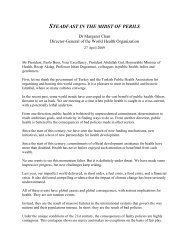The Evolution of HTA in Emerging Markets Health-Care ... - TREE
The Evolution of HTA in Emerging Markets Health-Care ... - TREE
The Evolution of HTA in Emerging Markets Health-Care ... - TREE
Create successful ePaper yourself
Turn your PDF publications into a flip-book with our unique Google optimized e-Paper software.
OHE Consult<strong>in</strong>g Report for PhRMA<br />
5 January 2011<br />
<strong>The</strong> development <strong>of</strong> collective fund<strong>in</strong>g arrangements <strong>in</strong> itself has the potential to drive up<br />
expectations about access to health care. This was particularly evident <strong>in</strong> Brazil: the emphasis there<br />
on health care as a ‘constitutional right’ creates demands that outstrip available resources. Although<br />
the share <strong>of</strong> Government spend (12% <strong>of</strong> tax revenue at the state level) is not too far beh<strong>in</strong>d<br />
developed economies, this still represents a relatively low absolute spend per person (US$837<br />
compared to $4028 <strong>in</strong> OECD countries <strong>in</strong> 2008 (OHE calculations based on OECD <strong>Health</strong> database for<br />
2010).<br />
Lesson 1: Incomes are grow<strong>in</strong>g <strong>in</strong> emerg<strong>in</strong>g markets, but result<strong>in</strong>g <strong>in</strong>creases <strong>in</strong> fund<strong>in</strong>g for health<br />
care are likely to be out-‐paced by ris<strong>in</strong>g demands and expectations. In such situations, <strong>HTA</strong> may have<br />
a role <strong>in</strong> assist<strong>in</strong>g the health care system to reconcile rapidly expand<strong>in</strong>g demand with more slowly<br />
expand<strong>in</strong>g resources. <strong>HTA</strong> can provide a potential means <strong>of</strong> handl<strong>in</strong>g this <strong>in</strong> a more explicit and<br />
transparent way, and <strong>in</strong> promot<strong>in</strong>g public debate about priorities.<br />
<br />
<br />
However, address<strong>in</strong>g ‘ration<strong>in</strong>g’ <strong>in</strong> this way requires a will<strong>in</strong>gness to engage <strong>in</strong> active debate<br />
about ways <strong>of</strong> address<strong>in</strong>g demand and supply.<br />
Such a debate will <strong>in</strong>evitably refer to the appropriate balance between national<br />
procurement and <strong>in</strong>dividual cl<strong>in</strong>ician decision mak<strong>in</strong>g.<br />
Degree <strong>of</strong> centralisation<br />
As we have noted, <strong>in</strong> all three countries the degree <strong>of</strong> centralisation is relatively high or <strong>in</strong>creas<strong>in</strong>g:<br />
<br />
<br />
<br />
Brazil has public and private systems but the private system is centrally regulated. <strong>The</strong>re is<br />
regional and local control <strong>of</strong> the public system, but there is a constitutional right to health<br />
care, and the three major pharmaceutical programmes are national entitlements;<br />
Ch<strong>in</strong>a is <strong>in</strong>creas<strong>in</strong>g central control through an expansion <strong>of</strong> its three public schemes.<br />
National oversight is shared with Prov<strong>in</strong>cial adm<strong>in</strong>istration;<br />
Taiwan <strong>in</strong>troduced a s<strong>in</strong>gle payer system <strong>in</strong> 1995, and operates a national benefit package.<br />
In all three countries, however, there appears be little “active third party purchas<strong>in</strong>g” as we def<strong>in</strong>e<br />
this <strong>in</strong> our model <strong>in</strong> which the payer moves beyond passively adm<strong>in</strong>ister<strong>in</strong>g fee-‐for-‐service systems<br />
(occasionally cutt<strong>in</strong>g or capp<strong>in</strong>g fees to conta<strong>in</strong> costs) to decid<strong>in</strong>g actively what it is go<strong>in</strong>g to cover,<br />
who is go<strong>in</strong>g to provide it, and how they are go<strong>in</strong>g to be paid. In Brazil, there is some use <strong>of</strong> DRGs,<br />
and <strong>in</strong> Ch<strong>in</strong>a, an <strong>in</strong>terest <strong>in</strong> cost-‐per-‐case tariffs is emerg<strong>in</strong>g. However, there is some way to go<br />
before priorities are set and services purchased to meet those priorities.<br />
Another impact <strong>of</strong> “fee-‐for-‐service” as used <strong>in</strong> Ch<strong>in</strong>a and Taiwan is an <strong>in</strong>centive to provide additional<br />
services, especially those on which additional <strong>in</strong>come can be earned – either because fees exceed<br />
costs or because additional revenues can be earned on services not covered by the fee scale. In<br />
Ch<strong>in</strong>a, artificially low prices are set for ‘basic services’: this creates strong <strong>in</strong>centives for overuse <strong>of</strong><br />
new technologies, where providers are free to set higher prices. And <strong>in</strong> Taiwan, the difference<br />
between drug acquisition cost and reimbursement payments provides strong <strong>in</strong>centives to over-‐<br />
58








